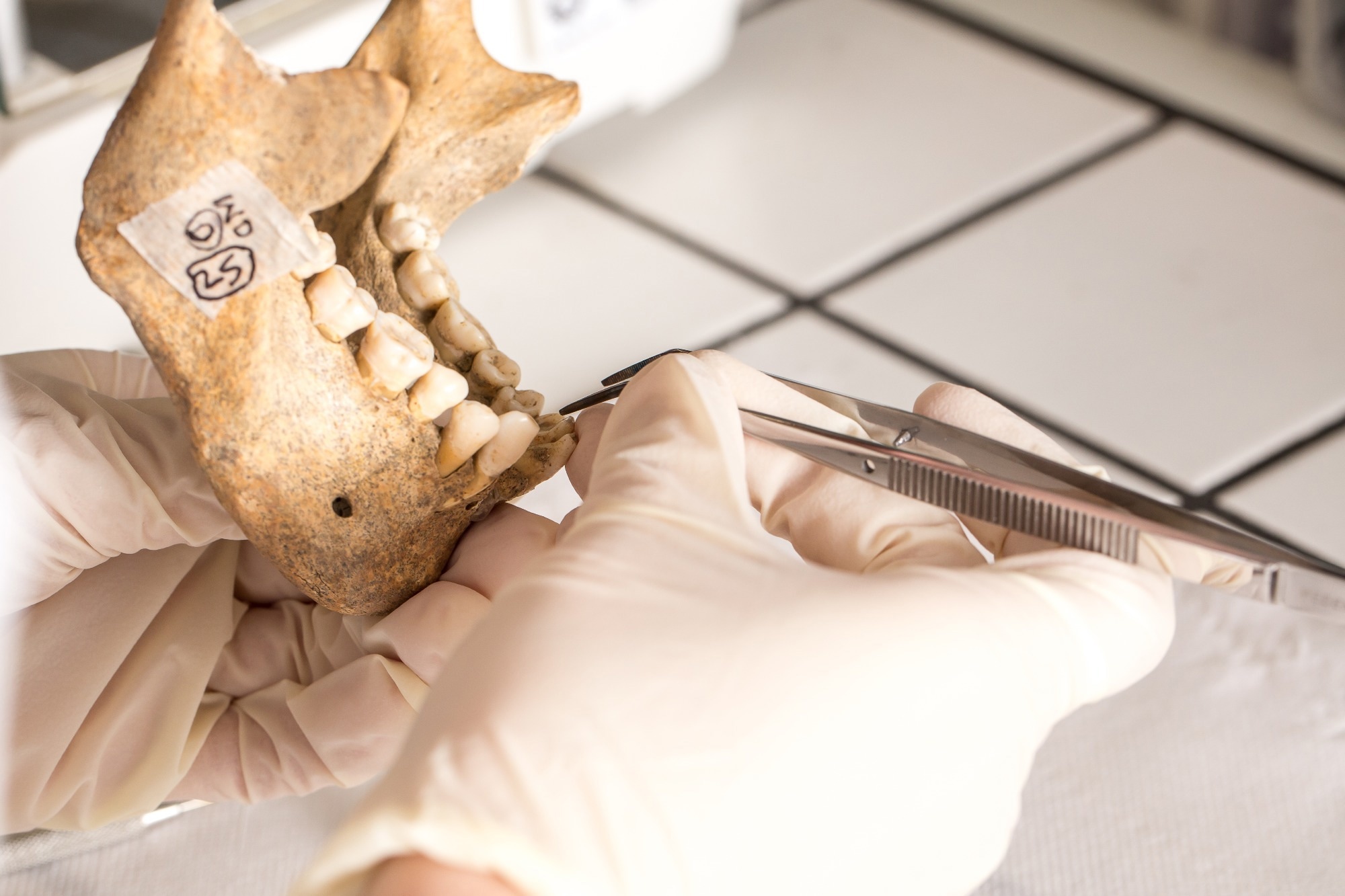In a recent study published in the Nature Journal, researchers described a new method to safely release deoxyribonucleic acid (DNA) trapped inside the ancient tooth and bone artifacts, which was used to analyze and identify the wearer or maker of a deer tooth pendant from the Upper Paleolithic period found in Denisova Cave, Russia.
 Study: Ancient human DNA recovered from a Palaeolithic pendant. Image Credit: sruilk/Shutterstock.com
Study: Ancient human DNA recovered from a Palaeolithic pendant. Image Credit: sruilk/Shutterstock.com
Background
Understanding the culture, subsistence strategies, and behavior of ancient humans from the Pleistocene depends largely on information gleaned from bone, tooth, and stone artifacts from this epoch.
While such artifacts are plentiful, unless found in rare burial arrangements, it isn't easy to associate them with specific individuals, limiting our understanding of the genetic ancestry or sex-based roles in the Pleistocene human society.
Furthermore, even if various artifacts are found close to each other, they might differ by hundreds or thousands of years in age.
Analysis of artifacts made of teeth or bones is promising because their porosity allows body fluids such as saliva, sweat, or blood to penetrate the artifacts, and the hydroxyapatite in teeth and bones absorbs DNA and protects it from nuclease activity and hydrolysis to a certain extent.
However, hitherto, the process of DNA extraction has involved destructive sampling and the risk of altering the specimens.
About the study
The present study tested four reagents as potential solutions for non-destructive DNA extraction using Paleolithic faunal remains of similar shape and size.
The tested reagents included a guanidinium thiocyanate, ethylenediaminetetraacetate (EDTA) solution, sodium hypochlorite solution, and sodium phosphate buffer with detergent.
While treatments with guanidinium thiocyanate solution and EDTA solution caused substantial alterations on the surface of the artifacts, the sodium phosphate buffer and detergent solution caused only minimal changes.
Therefore, the non-destructive method to extract DNA included serial incubations of the artifact at four different temperatures in sodium phosphate buffer. This protocol was applied to 15 osseous specimens from Quinçay Cave thought to be from Châtelperronian technocomplex layers and between 45 and 35 thousand years old, three tooth pendants from the Initial Upper Palaeolithic layers (45 to 43 thousand years ago (ka)), and one tooth pendant from Denisova Cave, between 39 and 34 ka.
The stepwise, temperature-controlled extraction of DNA allowed the researchers to monitor the different DNA components released during the extraction, such as endogenous DNA, ancient human DNA, environmental DNA from the sediments on the artifacts, and contaminant DNA from present-day materials. Fractions of DNA in phosphate buffer were then concentrated, isolated, and purified.
Single-stranded DNA libraries were prepared from the extracted samples, enriched using hybridization capture for nuclear and mitochondrial DNA, and sequenced using next-generation sequencing and shotgun sequencing methods.
Previously published Basic Local Alignment Search Tool (BLAST) and MEtaGenome ANalyzer (MEGAN) pipelines were used to assign the nuclear and mitochondrial DNA to the family-level classification of mammalian taxa.
Additionally, the coverage of autosomes and X-chromosomes was compared using the shotgun sequencing data to determine the sex of the human DNA samples.
Results
The results reported the recovery of deer and ancient human mitochondrial DNA from the tooth pendant from Denisova Cave, using which the pendant was estimated to be between 19,000 and 25,000 years old.
Additionally, sex determination using the shotgun sequences identified either the wearer or the maker of the pendant to be a female who was genetically affiliated to individuals from an ancient North Eurasian group, who were known to exist around the same time but had previously been found further east in the Siberian region.
Analysis of the deer mitochondrial genome successfully identified the species as Cervus canadensis, commonly known as elk or wapiti. This non-destructive DNA extraction method makes it possible to use teeth or bone artifacts as an untapped source of DNA from ancient humans who might have made, handled, or worn these artifacts.
This method also allows inferences to be drawn about the biological sex and ancestry of the humans who handled these artifacts, providing more insight into the behaviors and cultures of ancient humans.
The stepwise release of DNA in this method also allows the ancient DNA found deep within the artifact to be distinguished from present-day DNA that could have contaminated the artifact or DNA found in the surrounding sediments.
Additionally, the recovery of faunal DNA from the bone and the human DNA allowed independent estimations of the artifact's age.
Conclusions
To summarize, the study described a novel, non-destructive method of DNA extraction from ancient paleolithic tooth and bone artifacts that allowed the recovery of human DNA recessed within the porous bone or tooth.
Using this method, the researchers identified that a toothed pendant found in Denisova Cave was made from wapiti or elk tooth, and the maker or wearer was a female individual of Ancient North Eurasian ancestry, belonging to a group that was hitherto thought to occupy areas further east of Denisova Cave between 19 and 25 ka.